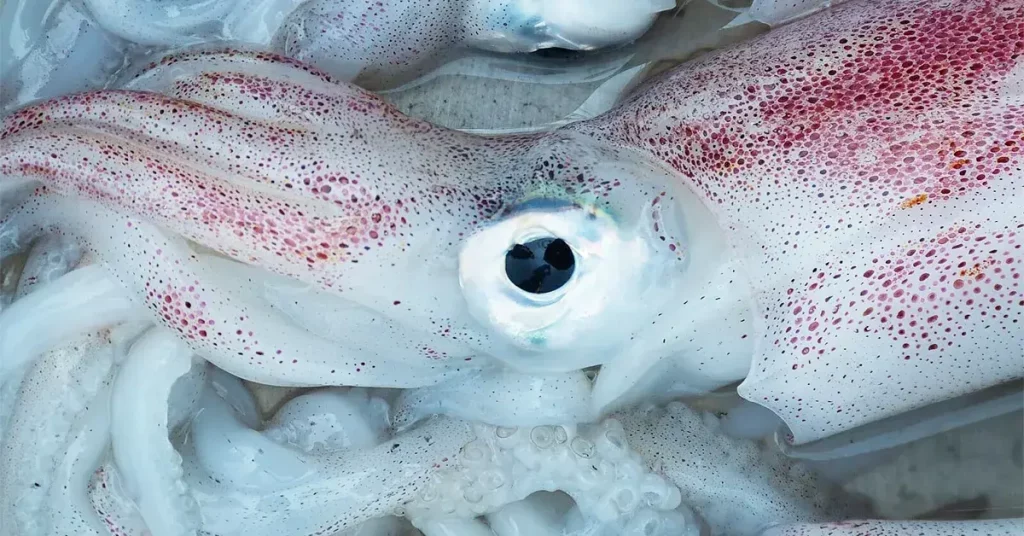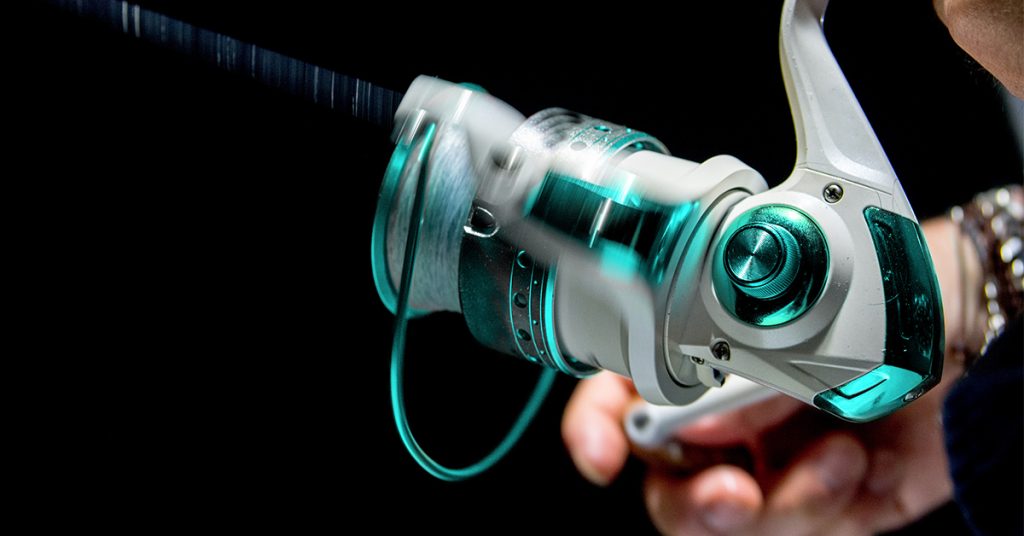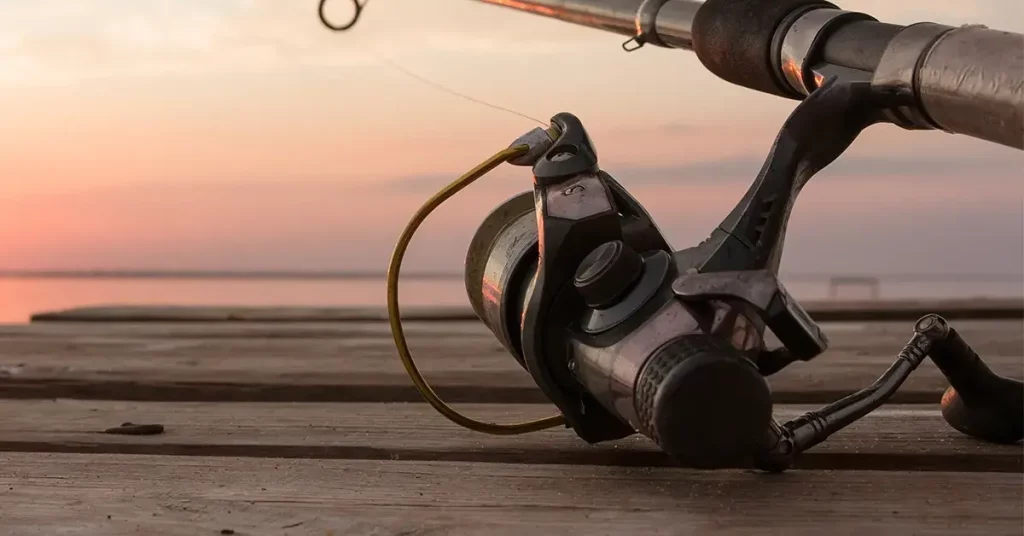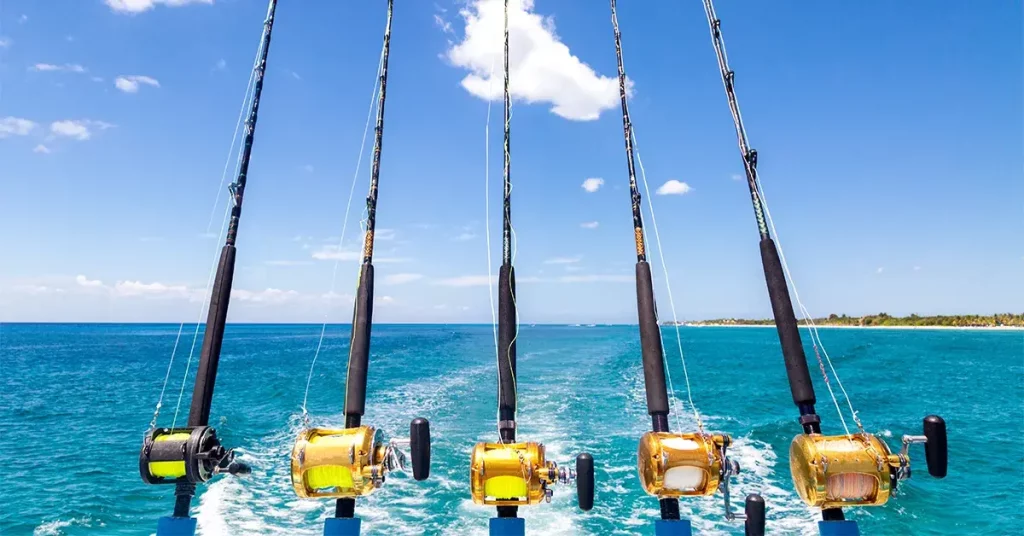While they might not get the same level of attention as larger game fish, squid makes for some great fishing. They’re easy to catch, work great as bait, and taste delicious when prepared well. They’re also pretty incredible creatures – they can change color to blend in with their surroundings, can squirt ink to evade predators, and are pretty crafty.
Squid behavior differs from typical fish behavior, as they’re actually cephalopods. They won’t attack bait with the same vigor as most fish do, but have a tendency to use their tentacles to slowly draw their prey towards their mouth.
There are several effective methods of catching squid, but by far the most common is jigging with a specialized squid jig. These prawn shaped jigs often feature bright colors, glow in the dark patterns, and realistic action built to attract squid. Instead of a hook, the bottom features one or more layers of upward-facing trick hooks that entangle a squid’s tentacles before it knows what’s going on.
Let’s take a look at when and where you can find squid, how to catch them in detail, as well as what to do with them once you’ve caught some.
Where to Catch Squid?

Before you can start catching squid, you’ve got to know where to find them. Luckily, squid is plentiful throughout most of the world and can be caught during any season. They like calm, clear water near seagrass and weed beds, and can often be found in protected jetties or bays near the open ocean. While a boat can definitely help you locate good squidding locations, the end of piers and jetties can also work well.
As they’re both predator and prey to a wide variety of species, they like environments with plenty of cover to ambush and hide in. Rocky, reef-like structures are perfect for them to hide out in wait for prawns, crabs, and small fish.
They can be finicky when it comes to water quality, so polluted water near busy marinas or ports is generally a no go. They’re mostly inactive in rough water – so the best times to go squidding are when it’s calm, or slightly windy.
Best Time of Day to Catch Squid
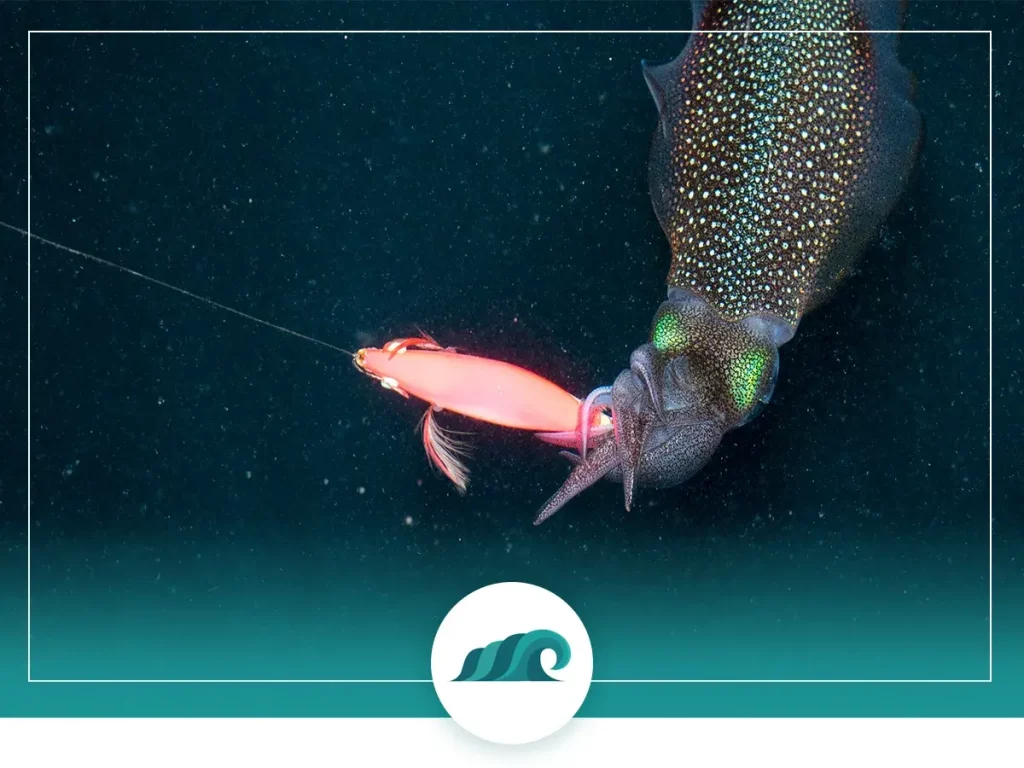
Much has been said about the best time of day to catch squid. In fact, many squid fishermen swear that certain moon and tide cycles produce more squid activity. While there might be something to this, generally all you need to know is that squid like to feed at nighttime and in low-light. The least productive time to catch squid is at midday when the sun is bright and powerful.
Because they prefer to feed at night, using bright bioluminescent jigs can help attract them in the dark. They also seem to be attracted to artificial lights at night. Keeping several bright lights on your boat can help attract curious squid to your area.
While they’re easier to catch in the dark, you can still catch them during the day – you’ll just need to work a little harder. During the day, you’ll need to fish a little deeper, and as they’re holed up, you’ll probably need to work your jig a bit harder to coax a bite.
Squid Gear
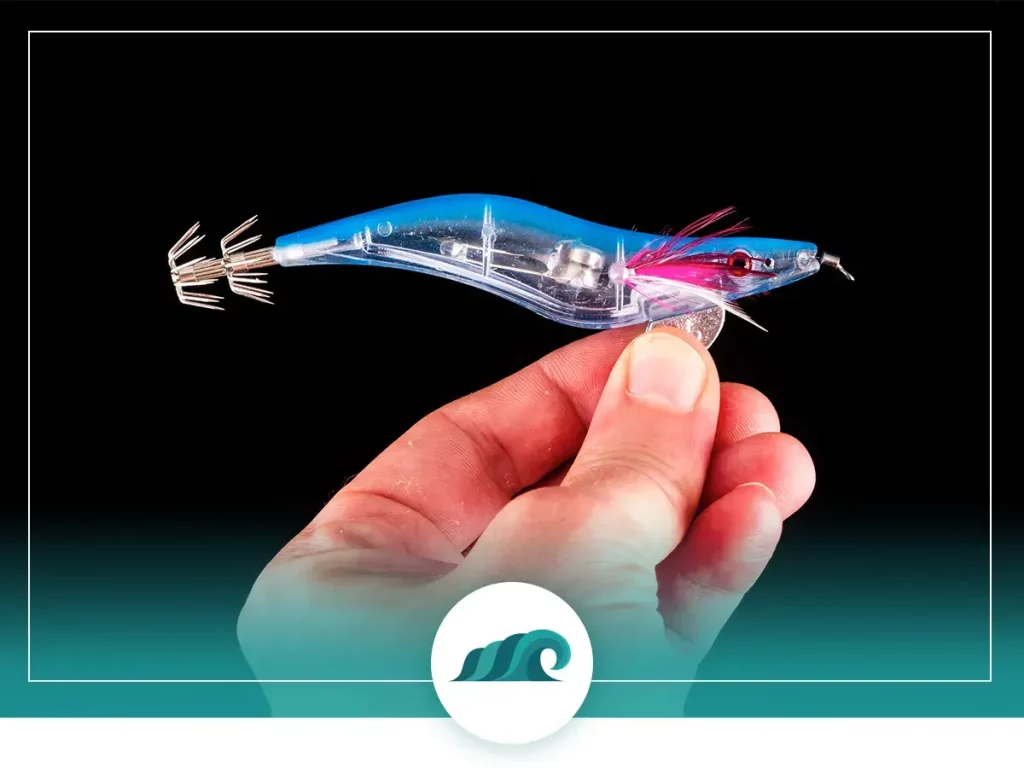
What gear do you need to start catching squid?
Squid Rods
One of the great things about squidding is that it’s what you make of it. You can get by with a cheapo rod/reel combo and a couple of jigs, or you can splurge on a nice 9-foot Japanese style egi rod that will have your jig dancing like a ballerina.
For a squid jigging setup, you’ll ideally want a long, slow-action graphite rod in the 8 to 9 foot range. This is the Japanese egi method – and will give you the ‘whip’ needed to really work the jig – and make it dance like a real prawn. It will also enable you to cast the jig over longer distances, so you can cover more water.
If you don’t have a rod like that, you can also use a lightweight 7 to 8 foot trout rod, although you won’t be able to work the jig quite as effectively.
Squidding Rods:
- Egi Style Rod: Pro Marine Egi Rider
- Lightweight Trout Rod: St Croix Triumph
Squid Reel
Almost any decent spinning reel can work well for catching squid. However, if you were to pick one, a good squidding reel would be a lightweight saltwater spinning reel in the 2500 to 3000 size range. You don’t want to go too small as this can make your retrieve take longer, giving the squid time to wriggle its way free.
Squidding Reel:
Squid Line
When it comes to line, you’ll want to go as light as possible while still being strong enough to pull your lure out should you get snagged in the weeds. This will help with working the jig and feeling when a squid is on your line. Both braid and mono can work, but many squid fishermen prefer 8 to 10 lb. braid due to its lack of stretch and bite detection capability.
Line color may be an issue during the day in really clear water, but most of the time even high viz line will work fine. You’ll generally want to use a 3 – 4 foot fluorocarbon leader, especially when fishing around rocky or reefy environments.
Squidding Line:
- Braided line: KastKing SuperPower Braided Fishing Line
- Fluorocarbon Leader: Seaguar Blue Label 25-Yards Fluorocarbon Leader
Squid Jigs
Now onto the main event of squid fishing – the squid jig! This is the one piece of gear you absolutely need to catch any squid. These specialized jigs are built to do one thing and one thing only – catch squid!
The simple but effective design actually dates back at least 500 years to the medieval Japanese. It uses a weighted or unweighted oblong lure – usually between 2 and 4 inches – with multiple sets of upward-facing barbless spikes. These spikes will tangle a squid by its tentacles before it has the chance to escape.
The most common jig type features a keel-shaped chin with a built-in weight. This will cause it to sink at a 45 degree in the water, mimicking the behavior of bait. Popular colors are pink, orange, and green.
Surprisingly, there’s a lot to consider when picking out the ideal jig for a given situation. Factors like light-levels, squid activity level and water clarity all play into how effective a jig will be.
Your best bet is to get a bunch of different jig colors and sizes and experiment to see what works best. As you’ll mostly be fishing in weedy areas, you’re bound to lose a jig or two over time, so make sure to pick up a few different ones.
Squid Jigs:
- 2-Inch Jig: Yo-Zuri Squid Mini Aurora Floating Jig
- 3 ½ Inch Jig: Yo-Zuri Squid Jig
- 3 ¾-Inch Jig: Yo-Zuri Squid Ultra Bait Aurora Sinking Jig
- Multi-Pack: Croch Squid Jig Shrimp Prawn Lures
- Leader with Hooks: Ahi USA Squid Catcher
Other Gear Needed
There are a few other pieces of gear that will make your squidding experience that much easier.
As squid are attracted to artificial light, a bright waterproof headlamp is great for fishing in the dark and will help you see what’s going on around you. I’m a big fan of the Fenix HL60R myself.
If you want to really step your game up, bring a powerful floodlight to penetrate the water and entice the squid.
Once you start catching squid, a 5-gallon bucket is one of the best ways to store them until you’re ready to clean them later. As they travel in schools, once you snag one, you can often throw your line back in the water and hook others nearby. A bucket is a great way to stash squid when you’re in a hurry to get your line back in the water.
Squid Jigging Techniques

Once you’ve got your gear in hand, you’ll need to learn how to start catching these wriggly critters.
Fishing for squid is more about the final result than the fight. They don’t fight like game fish; in fact many times you’ll have to be focused on your line to detect a bite at all. You’ll also need to set the hook, as they often won’t get hooked otherwise.
As most jigs are on the heavier side, you can really belt them out and get some distance while casting. Look for areas with kelp, weeds, or other vegetation they can use as cover. Let the jig fully sink to the bottom, and then give it a sharp upwards jerk about 2 to 3 inches. Allow the jig to sink once again, reel in the slack, and repeat the process until you hook a squid or your lure is all the way back. You’re trying to mimic the behavior of a prawn.
Don’t be afraid to alter your retrieve by changing your speed, pattern or motion. What works one day may not be ideal for all situations.
Unlike when a fish takes your lure, you’ll notice a squid bite when your rod tip moves upwards. You won’t feel much other than an increased weight on your line, which is a good indicator you’ve got something. Keep the line tight, and prevent any slack, as that can present an opportunity for the squid to slip off the barbless hooks.
When you’ve got the squid nearby, don’t think you’re home safe – it’s still got a few tricks up its sleeves. Watch out for ink, they can actually aim really well, and you can get covered in an inky blast if you’re not careful! A good landing net can help here, as they’ll shoot their ink into the net rather than all over you.
How to Cook and Clean Calamari
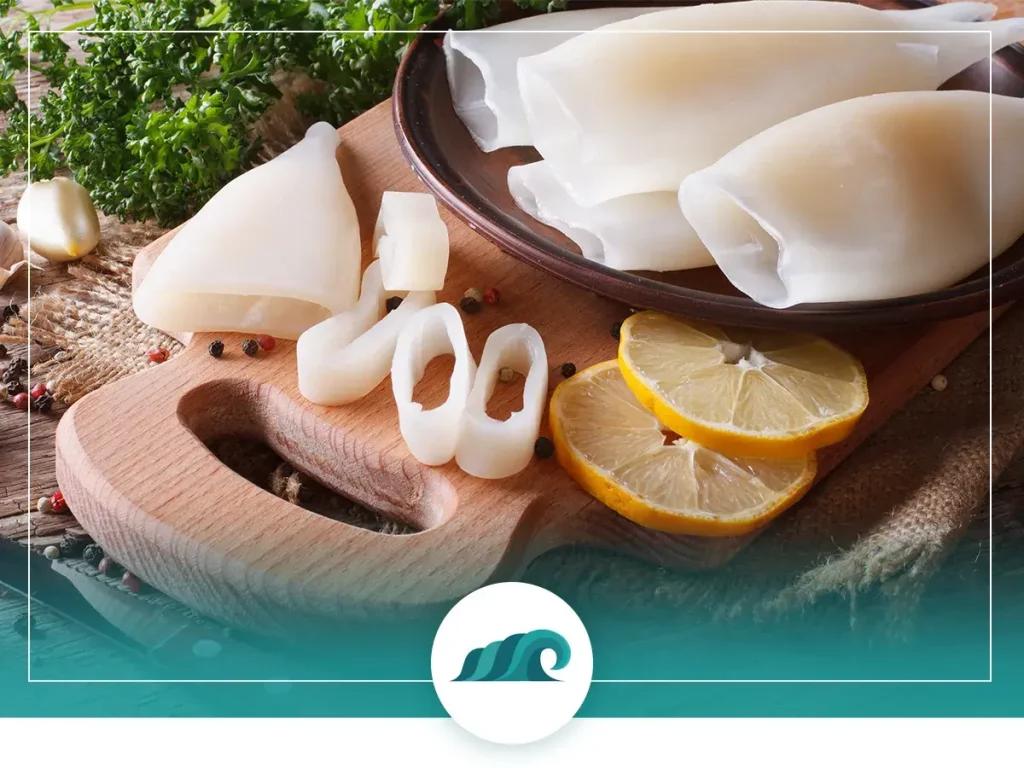
The best part of squidding is in the eating. After all, who doesn’t like a piping hot plate of fresh calamari!
If you’ve only had the frozen stuff, you’re in for a real treat. Fresh calamari has an incredibly soft texture and tastes leaps and bounds better than those frozen tubes from the store.
Before you can start cooking, you’ll need to clean your catch. Some people find this process a little difficult, but it’s actually not that bad if done right. Also, nothing goes to waste, as all the inedible bits make fantastic bait.
To clean squid:
- Grab the head above the eyes in one hand, and the mantle (the large tube covering the head) in the other. Pull apart.
- Cut the head right in front of the eyes. Make sure the beak is removed from the tentacles. You can freeze the guts and upper head to use as bait later on.
- Puncture the skin near the side flaps with your thumb and peel off the plastic-like membrane on the outside of the mantle.
- Clean and rinse out the interior of the mantle.
- Cut the squid into ring-shaped pieces for cooking.
Squid Recipe
So what’s the best way to cook squid after the catch? Of course, fried calamari is tough to beat – but fresh squid can also be grilled, braised, sautéed, or eaten cold in a salad – all with fantastic results.
Fried Calamari
Ingredients:
- 1 to 2 pounds fresh Calamari cut into tubes
- 2 lemons cut into wedges
- 2 cups flour
- 1 tsp. salt and fresh pepper
- ½ tsp. cayenne pepper
- Oil or lard for frying
- 1 cup buttermilk
Directions:
- Soak the calamari in buttermilk for 10 minutes or so.
- Heat your oil in a deep cast iron pan or a deep fryer.
- Combine flour, spices, salt, and pepper in a bowl.
- Take the calamari out of the buttermilk and dip into the flour mixture. Repeat a second time for a thicker coating.
- Drop coated calamari into hot oil for about 2 to 3 minutes, until golden brown. Remove from oil and drain on a paper towel.
- Sprinkle calamari with salt and pepper, squeeze lemon wedges, and serve with marina or tzatziki sauce.

